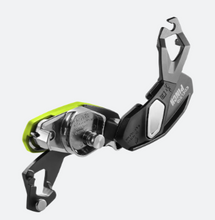
The Edelrid PINCH is a new belaying experience. This versatile assisted braking belay device is designed for sport climbing, multi-pitch climbing and rope access techniques.
The PINCH is the first device on the market that can be attached directly to the central ring of the climbing harness without an additional carabiner. Thanks to its low, close-to-the-body position, the PINCH does not need to be fixed in place when releasing the rope and the brake rope can always be gripped with all fingers. In addition, the compact belay system provides an increased span, which allows the belayer to pay out 20 - 30 cm more rope at once.
The linear rope, run through the frontal steel braking grooves, reduces rope tangles when lowering and abseiling. In addition to the lowering lever, the speed can be controlled by the pressure of the braking hand, which contributes to increased braking rope control, especially when using thin, soft ropes. The anti-panic function provides added safety not only for beginners.
A special feature is the integrated second braking tier, which enables controlled lowering by pulling the lowering lever further when securing particularly light persons or in systems with high rope friction. Users and experienced rope access technicians can permanently deactivate the anti-panic function using a screw supplied.
Another plus: When used on multi-pitch lengths, the PINCH is the only device on the market that can be attached to the belay station in four different directions in 90° increments. This means that the lowering lever can always be brought into a position in which it can be operated freely.
Features
- Assisted braking belay device for versatile use in sport climbing, multi-pitch climbing and rope access
- Position close to the body due to direct harness attachment increases brake rope control and improves usability
- Direct harness attachment eliminates the risk of cross-loading the belay carabiner
- De-activatable anti-panic function for increased safety by automatically locking the device if the lowering lever is pulled too far backwards
- Second braking tier if the anti-panic function is activated too frequently due to insufficient load and/or excessive rope friction
- Frontal steel brake grooves allow the rope to run linearly and ensure less rope tangling, increased durability and prevent unsightly discoloration that occurs when the rope rubs against aluminum
- Attachment to the belay station in four different directions in 90° increments
- Equal operation for right and left-handed users
- Suitable for static ropes from 10.0 to 10.5 mm diameter (120 kg max. user weight)
- Suitable for dynamic ropes from 8.5 to 10.5 mm diameter
Technical Information
- UIAA
- Approved rope diameter: 8,5 - 10,5 mm
- Certification: EN 15151-1
- Certification: EN 12841-C
- Material: Steel/ALU
- Mechanical
Downloads:
Inspection Instruction Belay Devices
Edelrid Frequently Asked Questions (FAQs)
The braking hand must always hold the braking rope.
The assisted braking mechanism is designed to activate independently of the braking hand. However, a braking hand on the rope is required at all times. Refer to our user manual for further details.
Yes, that is one of the main primary applications of the PINCH.
There are no teeth in the frontal groove. The braking ribs add friction when using softer ropes or smaller diameter ropes, and are designed to guide the rope smoothly through the device.
Yes. Check out our Multipitch Tutorial for the PINCH here.
We are currently in the process of evaluating the PINCH for rope soloing. For the current status, please refer to our user manual.
We are currently in the process of evaluating the PINCH for rope soloing. For the current status, please refer to our user manual.
The rope can be locked at the anchor as shown in this video at 03:00 minutes. We are currently preparing a separate video tutorial covering various techniques. Abseiling on single ropes is not a new technique and advice can also be found in alpine climbing courses or educational books.
No, the cam has a stopper that keeps loop and rope separate.
The PINCH offers 4 attachment points in 90°-increments of orientation when fixing it to the anchor point. A preferable orientation would be where both the lever is accessible and the cam works freely (as in minute 02:18 of our PINCH Multipitch Tutorial here).
Could you provide information about the various certifications and how they are directly applicable?
Check out our website for detailed descriptions of the certifications:
EN 15151-1
EN 12841-C
Can the opening mechanism open accidentally?
The opening mechanism involves a multi-step action: you need to swing open the side plate while simultaneously pressing the button. Furthermore, the geometry of the side plates prevents any accidental opening of the device under load even if you manage to press the button. You can optionally use a carabiner as a backup using the direct attachment method, or choose the conventional method using a locking carabiner.
Of course, the device is field- and lab-tested for both attachment methods. Each of the methods can have its advantage, and since the PINCH offers both, it is up to the user to decide whether direct attachment or the conventional method suits best. Check out our tutorial video on the basic functions of the PINCH.
Is it safe to attach the PINCH directly to the central ring of the harness?
The PINCH is certified for this belt connection, which requires that the mandatory risk analysis has also been approved by the certifying institute. Furthermore, the device can be attached in the conventional way using a connecting carabiner.
How do you remove the PINCH from your harness?
Removing the PINCH is done in the reverse order of installing it to the harness.










